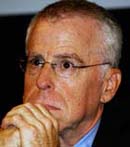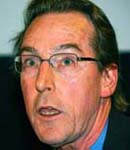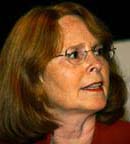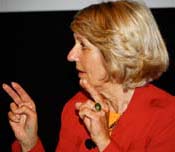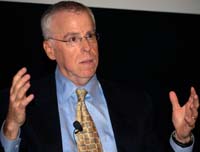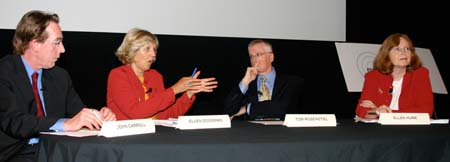| The Campaign and the Media 1 |
||||||
|
Thursday, Sept. 25, 2008 John Carroll is a professor of mass communication at Boston University and senior media analyst for WBUR-FM. Previously, he was a radio commentator for WGBH-FM, and a correspondent for WGBH-TV's Beat the Press, a weekly media review program. Prior to joining the BU faculty, Carroll was the executive producer of Greater Boston, WGBH-TV's nightly news and public affairs program. Ellen Goodman is a syndicated columnist for the Washington Post Writers Group whose work appears regularly in the Boston Globe. In 2007, she was a Shorenstein Fellow at Harvard’s Kennedy School of Government, where she studied gender and the news. Tom Rosenstiel is director of the Washington-based Project for Excellence in Journalism where he is the editor and principal author of its Annual Report on the State of the News Media. A journalist for more than 20 years, he is a former media critic for the Los Angeles Times and chief congressional correspondent for Newsweek magazine. He is the author with Bill Kovach of The Elements of Journalism: What Newspeople Should Know and the Public Should Expect. Moderator: Ellen Hume is the research director for the MIT Center for Future Civic Media. She was a White House and political correspondent for the Wall Street Journal, national reporter with the Los Angeles Times and regular commentator on PBS’s Washington Week in Review and CNN’s Reliable Sources. Co-sponsors: Center for Future Civic Media and Technology and Culture Forum. A webcast of The Campaign & the Media, 1 is now available. By Helene Moorman Photos by Greg Peverill-Conti [this is an edited summary, not a verbatim transcript] Tom Rosenstiel said that presidential campaigns reveal a lot about the current state of political journalism because the media is so heavily concentrated on a single story for an extended period. This election has highlighted the fact that the traditional model of verification-based reporting is no longer universal. Print sources still largely adhere to it, and they've been the ones to unearth most of the real facts about the candidates. But cable news, which has devoted 62% of its airtime to the election, has broken few actual stories. Instead, most of that time has been dedicated to discussion by analysts and campaign operatives, who derive much of their material from the web and from each other. Certain patterns haven't changed. Research by the Project for Excellence in Journalism revealed that news stories on the presidential campaign were divided as follows: 65% concerned campaign strategy and tactics, 20% was related to policy, 8% to the personal biographies of the candidates, and 3% examined their public records. These proportions are similar to what they were 25 years ago. John Carroll asserted that the news media this year is both more of a presence and less of a factor in the election than it has been in the past. The cable networks, he said, devote a lot of time to the campaign but don't change anyone's opinions. They're aimed at specific audiences, and their effect is mostly to reinforce what those audiences already believe. Print journalism, on the other hand, does deliver stories that have the potential to influence the discussion, but it doesn't have the impact it used to. One reason for this is the 16-hour news cycle, which emphasizes only the most recent events instead of the most important. People don't base their decisions on the news to the same extent they used to, which makes it possible for a candidate like John McCain to bypass or delegitimize the media without hurting his campaign. Ellen Goodman compared the American media's current trend of becoming more and more segmented along ideological lines to the traditional European model of print journalism in which each party has its own newspaper. Returning to the question of the media’s declining influence, Rosenstiel blamed the proliferation of commentary. Even though the purpose of journalism is to promote discussion, the volume of opinion has become so loud and continuous that the facts are obscured. Furthermore, a lot of this material is coming not from the journalists themselves but from "analysts" who have ties to the campaigns and are skilled at denigrating facts that are harmful to their side. It's essentially campaign spin posing as news, and it weakens the factual influence of the media. According to Carroll, there's no longer a particular segment of the media that leads the discussion by deciding which stories to cover. That role used to be fulfilled mainly by the biggest newspapers, from which other sources would take their cues. Now that direction is just as likely to come from places like YouTube, the news site Politico, or Jon Stewart on The Daily Show. The result is that certain sources may be influential within their small universe of coverage, but widespread impact is very difficult to achieve. Rosenstiel agreed, adding that the type of media that takes the lead at any moment depends on the nature of the story being covered. Blogs, for example, are very good at turning up pertinent material that's been published elsewhere, but not at street-level reporting. That's why when Sarah Palin's nomination was announced, the first wave of information about her came from the blogosphere, which had unearthed stories about her mayoral and gubernatorial history from the online archives of Alaskan newspapers. Once newspaper and broadcast journalists had made it to Alaska and started reporting, the main source of news about Palin became the traditional media. Weeks later, home videos of her began surfacing in places like YouTube. What's troubling, said Rosenstiel, is not which type of media is in control at a particular moment, but that the widening of the field gives more influence to those trying to manipulate the public. Journalism’s role as a filter for lies is being weakened. Asked about the impact of corporate ownership on the news media, Goodman claimed that it has not had a significant effect on the quality of newspaper coverage. Instead, the recognition that the economic model supporting newspapers has broken down has translated into a generalized anxiety among editors and especially reporters, who are often overworked because they are now expected to create blogs and other material for the online version of their papers. Moderator Ellen Hume asked the panelists to discuss which sources provide reliable, unbiased news. Carroll responded by pointing out that the unit of value in news has recently shifted from the package (such as a newspaper) to the individual story. People aren't looking for sources that contain a balanced set of perspectives anymore because they're able to use new technologies to assemble their own broadcast or newspaper that reflects (and reinforces) the opinions and interests they already have. Rosenstiel cited the website Politico as an interesting new model of journalism. It's staffed by professional newspaper editors but is not owned by a newspaper, and it only covers politics. The site leaves the recording of day-to-day activities in Washington to the traditional news outlets and instead focuses on enterprise pieces that cover new ground. The narrow focus keeps overhead low, and attracts a relatively small but devoted audience. Hume asked the panelists what happens when a false story takes hold during an election. Goodman brought up the "Obama is a Muslim" story, pointing out that 20% of people continue to believe this even though the media has repeatedly reported that it's a lie. Carroll went as far as to say that the response of the media to candidates' lies has almost no effect on public opinion. Politicians believe that power grants them the ability to construct reality, and they've gotten so good at it that the media is somewhat powerless. Rosenstiel disagreed, saying that politicians' desire to control facts is nothing new, and that the media is not powerless to uphold the truth. McCain may be at war with the press, but that's just made the press more aggressive toward him, and it will not ultimately be a successful strategy. Hume was surprised by Rosenstiel's opinion, reminding him that many previous Republican candidates have successfully run against the media. It may even work better this year because corporate influence has weakened many liberals' faith in the press. Shifting to the topic of how gender and race have influenced media coverage of the campaign, Goodman spoke about the importance of compelling narratives. Good stories capture the media’s attention, and the race and gender dimensions of this year's candidates have provided intriguing narratives that haven't been seen in a presidential campaign before. It's also interesting to look at the relationship between female politicians, female journalists, and female consumers of news. Traditionally, women have not paid asmuch attention to politics as men unless there was a female candidate. So they are more engaged in this election than in past ones, but not in the same way that men are. Women are looking at Palin's story as a personal one, and they are discussing it in a lot of settings that are not particularly politically oriented. Female journalists have also done a better job of covering Palin than male ones. Returning to the idea of competing narratives, Rosenstiel observed that often in this election a extensive news coverage of a particular candidate has correlated with a decrease in popularity. Interesting stories bring candidates into the spotlight, but that spotlight might have a negative effect. Audience Discussion QUESTION: Stories available through online news sources consistently generate large volumes of comments, and you mentioned earlier that cable news is mostly discussion as well. Have we become consumers of conversation rather than facts? ROSENSTIEL: Journalism has always been about discussion, but most of the discussion does originate from a set of facts. Blogs postings, for example, usually start by linking to an original media account of an event, and that forms the basis for the discussion. What's important to the consumer is not just the specific event or just the conversation, but the overall topic. CARROLL: The Huffington Post website's model is interesting in this respect, because it balances a very professional-looking appearance with a free-for-all on the comments pages. Sources like this that combine traditional journalism with the desire of the audience to participate are going to become more widespread. HUME: Historically, interest in politics declined as journalism became more objective and progressive. Maybe this shift toward conversation is a healthy way for people to stay engaged. QUESTION: Do all these new types of media allow third parties and alternative voices more of an opportunity to enter into the conversation? GOODMAN: It's possible that it could happen in the future, but I haven't seen it yet in the presidential campaign. Obama's success was due in large part to the internet, but it's not clear whether a third party candidate could be as successful. ROSENSTIEL: There was a lot of fear that technologies that allow people to filter the kinds of news they see would limit exposure to new things, but research shows that it hasn't happened. People are sharing all kinds of material within their social networks, which has the potential to make the culture more dynamic. However, the potential for it to change the way we elect our presidents is far more limiting. I haven't seen any evidence that the dialogue in this campaign has been elevated because of new media. QUESTION: The mainstream media has done a poor job of covering stories concerning the actual mechanics of the voting process. These are extremely important issues because nothing else matters if the votes don't get counted correctly. Why aren't we seeing this? CARROLL: This is an ideological issue. Those stories are being covered, just not in the places or the volume you believe they should. Instead of blaming the media for lack of coverage, citizens should take some responsibility for supervising the voting process if they believe there's a problem. GOODMAN: The corporate problem comes into play again here. Traditional news sources don't have the resources to cover everything, so stories that few people are interested in get dropped. HUME: This kind of story would lend itself to citizen journalism, what some have called crowd sourcing. It would be very powerful to have journalists aggregate and interpret data contributed by a large group of citizens. QUESTION: If the role of journalist is evolving, who defines that new role? ROSENSTIEL: The original norms of journalism came from the market, from what readers responded to. Future journalists are going to be defined by their ability to attract an audience, and also by their ability to subsidize themselves. The pressure on mainstream journalism today isn't lack of audience, it's lack of funding. If that issue can be figured out, the role of journalists might not change all that much because there is a growing audience for the traditional values of journalism. QUESTION: What kind of regional differences are there in the way people are tuning into this election? GOODMAN: There are some regional differences, but there is much more segmentation along education, class, race, and gender divides. ROSENSTIEL: Technology is helping to redefine the idea of community from geo-political communities to intellectual ones. The political information people are exposed to and the way they interpret that information has a lot to do with the intellectual communities they belong to. QUESTION: How much of the population actually has access to and uses all the technology that's been discussed, and how long will it take to be ubiquitous? ROSENSTIEL: A large chunk of the population is fairly disengaged, and gets what material it does consume mainly from traditional outlets, especially local television newscasts. Some 25% of the population are more interested, and are very eclectic in their media usage. And then there's another 12% that use mainly new media sources, and that population is generally young. Those that are already consuming news might shift more to the newer technologies in the future, but I don't think that technology alone will cause more than that third of the population to become engaged. QUESTION: The increasing partisanship and specialization of individual media sources are causing people to be subjected to fewer perspectives that are alien or surprising to them. Does this make the presidential debates a more important factor this year? CARROLL: People pay more attention to the mistakes that are made during the debates than they do to the policy that's discussed. I don't think the actual reasoned arguments have much effect, because the two sides don't agree on basic facts anymore. No one allows for the possibility that someone who disagrees with them might have a legitimate point of view, which makes it very hard to change minds. HUME: I don't think the debates are just about gaffes. The audience is looking for moments where the candidates' real personalities shine through. That could be a gaffe or it could be a moment of connection with one of them. |
||||||

